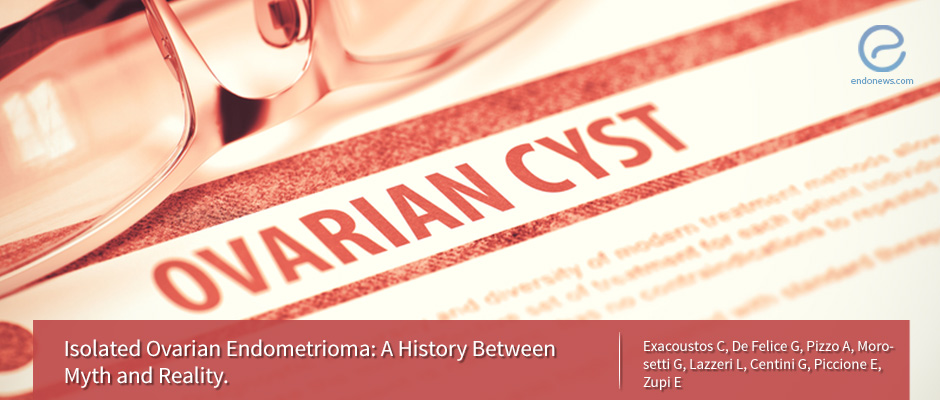Endometrioma and endometriosis
Sep 18, 2018
Endometriomas of the ovary are seen in association with endometriosis in the pelvis.
Key Points
Highlights:
- Ovarian endometriomas should prompt the search for deep pelvic endometriosis since they are frequently seen concomitantly.
Objectives:
- To assess the association between ovarian endometriomas detectable at the transvaginal ultrasound (TVU) and other specific extra-ovarian lesions including adhesions, deep infiltrating endometriosis, and adenomyosis.
What's done here:
- 255 women who had at least one ovarian endometrioma> 20 mm in diameter on ultrasound, in two different endometriosis centers in Italy, participated.
- Patients with painful menstruation and painful intercourse unresponsive to medical treatment (n=12), with pain and associated bowel obstructive symptoms (n=21), and with infertility (n=17) underwent laparoscopic surgery within 3 months after TVU; the remaining women were managed according to their symptoms and fertility desire either with medical therapy or assisted reproductive technologies.
- Researchers compared surgical and histological findings with the ultrasonographic preoperative diagnosis and performed statistical analysis.
Key results:
- Endometriomas were bilateral in 25.5% of all patients. Only 15% of the patients showed a single isolated endometrioma with no other signs of pelvic endometriosis/adenomyosis at the TVU.
- Pelvic adhesions detected in 73% of all patients and myometrial adenomyosis 53% of all patients by the TVU.
- Of all patients with endometriomas, 44.3% had deep infiltrating endometriosis. The accuracy of endometriosis diagnosis in different pelvic locations ranged from 88% to 100%.
- The size of the endometrioma was not related to the presence of deep infiltrating endometriosis.
Limitations:
- This study only included symptomatic patients in two referral centers specialized in endometriosis management.
- The surgical confirmation of endometriosis was available only for a small group of patients.
Lay Summary
Exacoustos C. et al. published an article titled “The isolated ovarian endometrioma: a history between myth and reality” in the Journal of Minimally Invasive Gynecology in 2018. They aimed to examine the association between ovarian endometriomas detectable at the transvaginal ultrasound and other specific extra-ovarian lesions including adhesions, deep infiltrating endometriosis, and adenomyosis. This is a retrospective study analyzing 255 women who had at least one ovarian endometrioma > 20 mm in diameter on ultrasound after presentation with pain or irregular menstruation. Women were from 20 to 40 years of age.
The researchers found the most common symptom for all patients with endometriomas at the transvaginal ultrasound to be painful menstruation (88.2%). Thirty percent of the patients were infertile. Mean endometrioma diameter was 40.0 ± 18.1 mm.
Authors found that 65 patients (25.5%) had bilateral endometriomas. Unilateral endometriomas were on the left side in 115 patients (45%). Patients who underwent laparoscopic surgery showed a higher percentage of bowel and urinary symptoms. Sixty percent of the patients showed endometriomas with the largest diameter < 4 cm. Transvaginal ultrasound findings showed pelvic adhesions in 73% of all patients and myometrial adenomyosis in 53% of all patients. Thirty-eight patients (15%) exhibited only a single isolated endometrioma with no other signs of pelvic endometriosis/adenomyosis at the transvaginal ultrasound. Of all patients, 21.5% showed posterior rectal deep infiltrating endometriosis and 36.4% exhibited a thickening of at least one uterosacral ligament at the transvaginal ultrasound.
In 44.3% of the patients with endometriomas, there was deep infiltrating endometriosis. The accuracy of endometriosis diagnosis in different pelvic locations ranged from 88% to 100%. Left endometriomas were more commonly associated with adhesions, rectosigmoid deep infiltrating endometriosis and endometriotic infiltration of the left uterosacral ligament. Researchers didn’t find any correlation between the size of the endometrioma and the presence of deep infiltrating endometriosis.
Authors concluded that doctors should explore all possible pelvic endometriosis localizations or concomitant uterine adenomyosis in patients diagnosed with ovarian endometriomas at the transvaginal ultrasound. In patients desiring future fertility, it is critical to choose the right management for patients with ovarian endometriomas and concomitant adhesions, endometriosis, and adenomyosis. Sonographers can easily recognize ovarian endometriomas, but adhesions and deep infiltrating endometriosis require a skilled imaging professional both for the transvaginal ultrasound and magnetic resonance imaging. Authors hope that dedicated training for sonographers can take place to overcome these challenges.
Research Source: https://www.ncbi.nlm.nih.gov/pubmed/29353008
adenomyosis deep endometriosis deep infiltrating endometriosis endometrioma pain transvaginal ultrasound endometriosis surgery

